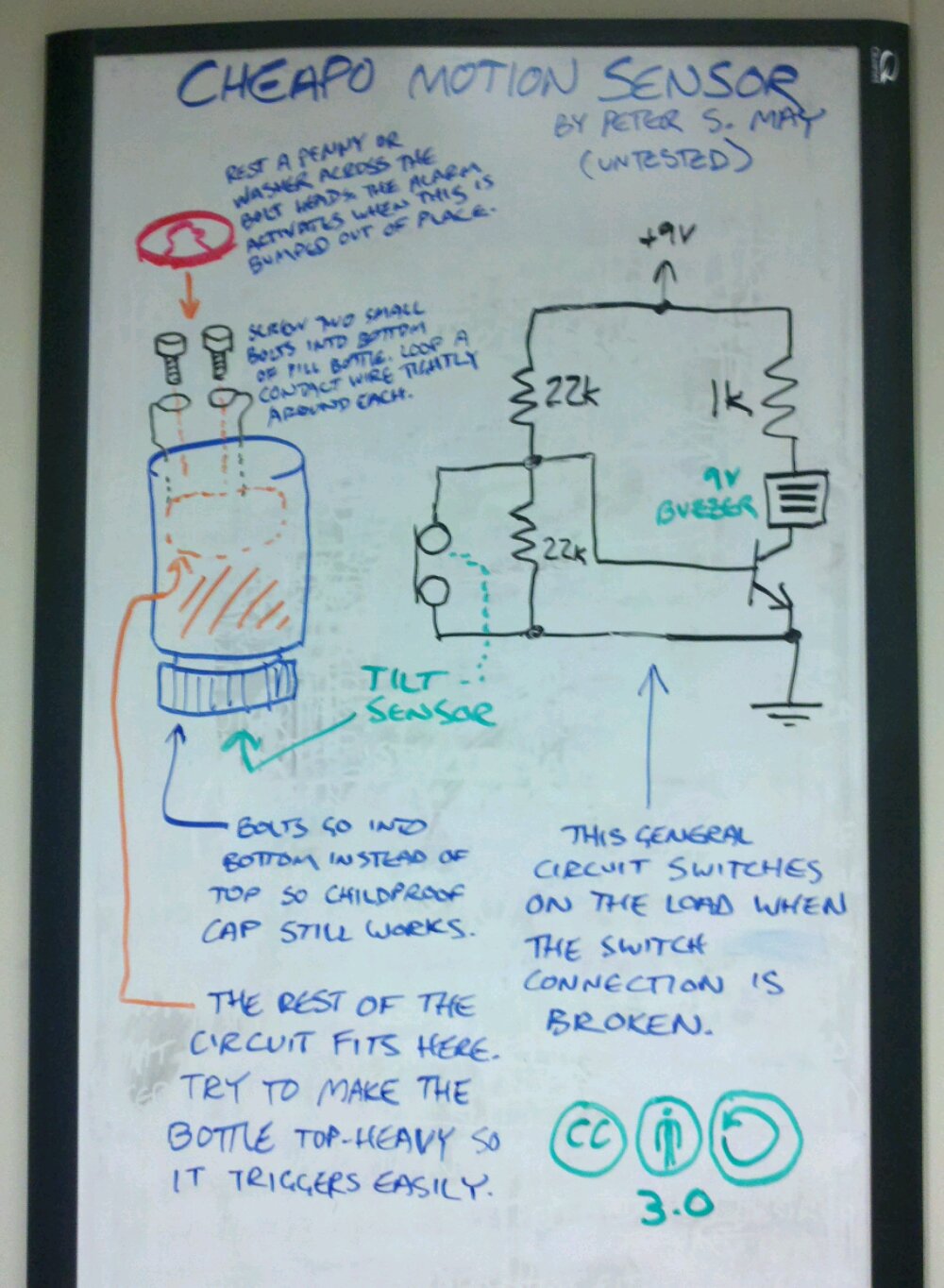Whiteboard: Cheapo motion sensor
After being unpleasantly startled that our jaw-style rat trap had, uh, done its job on a much smaller rodent, I decided that a less shocking audible warning might be useful. [Edit: See revision later in this post.]


This work is licensed under a Creative Commons Attribution-ShareAlike 3.0 Unported License.
This circuit is essentially a discontinuity tester: It has two contacts, and it makes noise if the connection between them is broken (cf. a continuity tester, a common multimeter function, which sounds when the connection is made). A simple transistor circuit is used to invert the typical functionality of the normally-closed switch, which is to switch a load on, not off, when the connection is broken.
I haven’t tested the circuit yet (I’m only short a 9V battery clip), but the idea is reasonably sound: When the switch is closed, the high-side 22k resistor drops all 9 volts of the supply, leaving 0V for the base of the transistor, causing it to remain off. (It thus draws about 0.4mA while off, which isn’t that bad, but I might try a heavier resistance to reduce the drain on the battery.) When the switch opens, the low-side 22k resistor is patched into the circuit. The voltage at the base is now at the middle of an even voltage divider, which brings it up not quite halfway (4.5V) to the top, but definitely above the 0.7V necessary to switch the transistor all the way on. The load, in this case a 1k resistor and a 9V-rated buzzer, now drops almost the full 9V (about 8.8V or so since Vce is around 0.2V) and is thus switched on.
[Edit: The circuit was basically sound, but I needed to remove the 1K resistor before the buzzer for it to turn on; later I realized that the low-side 22K resistor wasn’t really doing anything useful, so I removed that (and didn’t restore its connection). The revised schematic is below.]
The switch itself, which has been tested and works, is a couple of short bolts screwed a short distance apart into the bottom of a repurposed pill bottle (the top could have been used, but bolting the cap would cause it to cease to be child-resistant, and child-resistance is good in this case). A long lead is looped tightly around each bolt, which is then tightened to ensure contact. Then, a penny (or other coin or washer, as long as it’s small, relatively heavy, and conductive) is rested across the bolt heads, making a connection. When the bottle is disturbed, the penny is bumped out of place, breaking the connection and triggering the alarm. In this case, I’d seat the bottle behind the hinge on top of the trap so that the sensor is sure to fall over when the trap shuts.
The pill bottle or other enclosure should be selected to be a good deal taller than it is wide so that it disturbs more easily. It should be large enough to fit the circuit and the battery entirely inside. After installing the battery, it may be useful to add padding such as newspaper to fill the rest of the bottle. This would keep the sensor top-heavy, increasing sensitivity by preventing it from being too stable to trigger.
If I find that this thing works well, it may become an Instructable. At any rate, it’s important for any tinkerer to know that there’s absolutely nothing special about a mechanical switch—it’s just two pieces of metal (or other conductor) that can alternate between touching and not touching.
